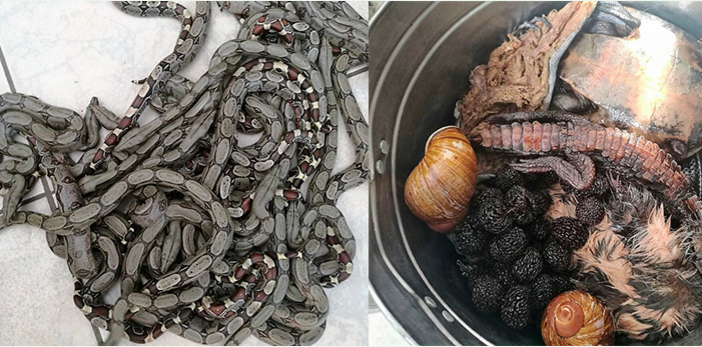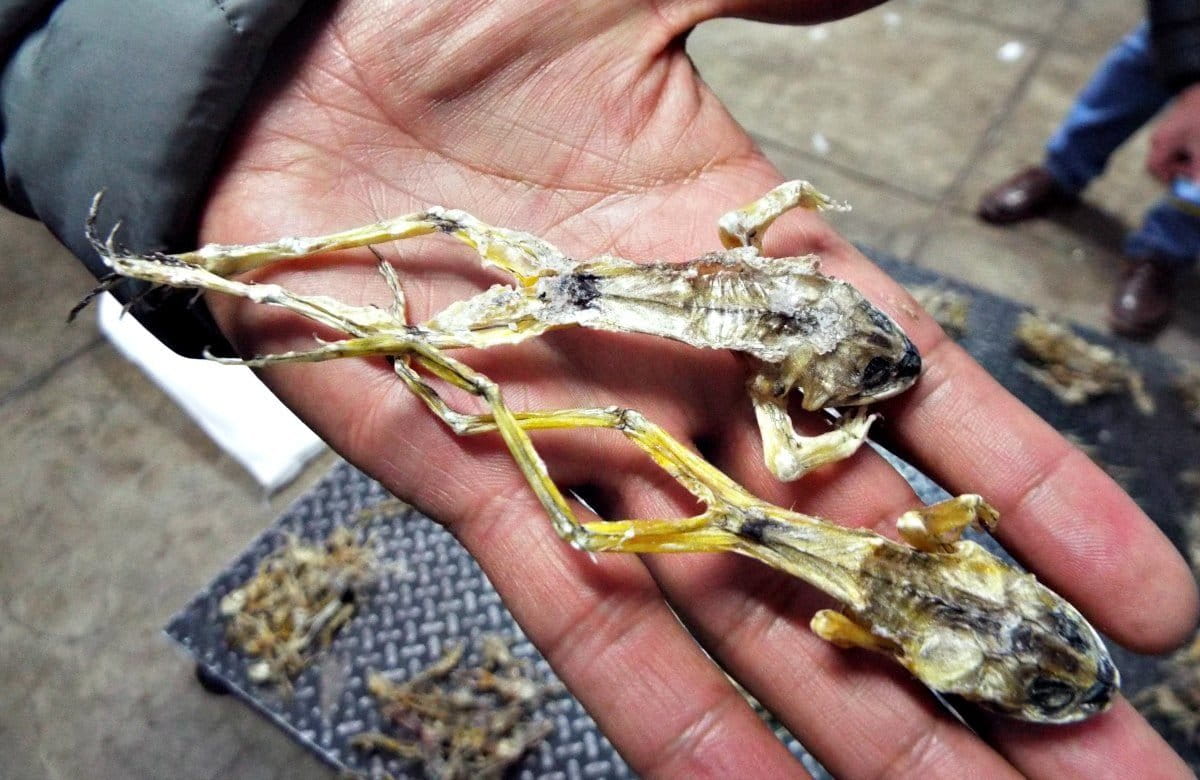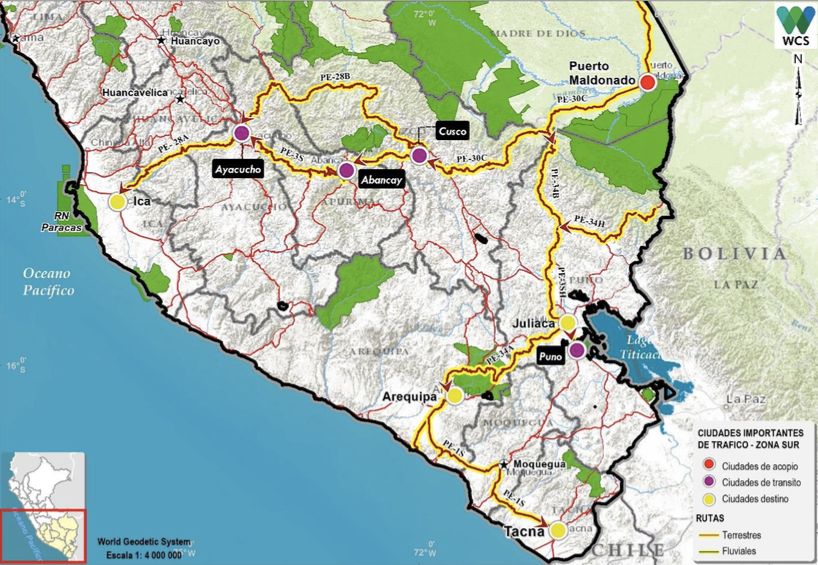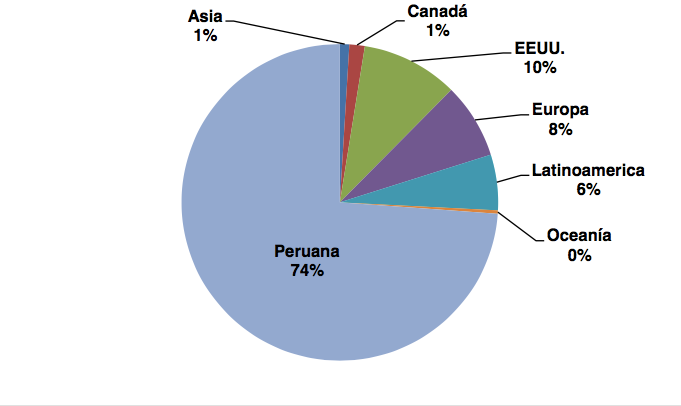- The Peruvian regions where wildlife is most trafficked are Loreto, Ucayali, Madre de Dios, Puno and Tumbes.
- There is a shortage of rescue centers for animals recovered from traffickers.
- Several of Peru’s cities serve as hubs for wildlife trafficking: Iquitos and Chiclayo in the northeast, Ucayali in central Peru, and Puerto Maldonado in the south.
Illegal traffickers want animals by any means necessary, even if they are endangered or if they suffer in transit. More than 380 wildlife species (211 birds, 101 mammals, 47 reptiles, seven amphibians and 17 invertebrates) have been illegally traded from across Peru to meet worldwide demand. The drivers of this trade vary: people want these animals for companionship, for their beauty or for scientific or ornamental purposes, among other reasons. These are the findings of a recent report from Peru’s National Forest and Wildlife Service (SERFOR), titled “National Strategy to Reduce Illegal Trade of Wildlife in Peru,” which analyzes this problem over a period of 15 years (2000-2015).
A considerable percentage of these species are vulnerable to extinction, either due to habitat loss or poaching. “Peru classifies its endangered species according to two systems of categorization,” explained Yovana Murillo, program officer for wildlife health and policy at the non-profit organization Wildlife Conservation Society (WCS). “The first is Supreme Decree 004-2014 of the Ministry of Agriculture and the other is according to the classification of the Convention on International Trade in Endangered Species of Wild Fauna and Flora (CITES).” WCS works closely with SERFOR on investigations into the wildlife trade, and analyzed the information collected in the agency’s study on trafficking.

Who are the victims of this trade?
According to SERFOR’s report on the wildlife trade, 9 percent of the most trafficked species in Peru (36 species) are listed in Appendix I of CITES, meaning they are threatened with extinction and barred from trade in virtually all circumstances; another 36 percent (137 species) are listed in Appendix II of CITES, which mandates careful controls on their trade. On the other hand, according to the Ministry of Agriculture’s classification system, 2 percent (eight species) of the most trafficked species are categorized as Critically Endangered and 5 percent (18 species) as Endangered.
Among the frequently trafficked species listed in Appendix I of CITES we can find the howler monkey (Alouatta palliata), Goeldi’s monkey (Callimico goeldii), Tumbes crocodile (Crocodylus acutus), Andean cat (Leopardus jacobitus), jaguar (Panthera onca), giant armadillo (Priodontes maximus), Humboldt penguin (Spheniscus humboldti) and bush dog (Speothos venaticus). Species listed in Appendix II and trafficked in Peru include the orange-winged parrot (Amazona amazónica), black spider monkey (Ateles belzebuth), boa constrictor (Boa constrictor) and red-fan parrot (Deroptyus accipitrinus).

Wildlife trafficking is the fourth largest crime in the world after arms, drugs and human trafficking, according to the United Nations Office on Drugs and Crime (UNODC). “This trade mobilizes up to 10 billion US dollars,” Jessica Gálvez-Durand Bernard, director of SERFOR’s division for Sustainable Management of Forest Heritage and Wildlife, told Mongabay-Latam. “One of the main reasons why these species are so vulnerable is the disappearance of their habitats. In the case of Peru, this is because of deforestation due to small-scale shifting agriculture or indiscriminate hunting, which has motives ranging from consumption for cultural reasons ─ in the case of the Lake Titicaca frog, which supposedly provides energy ─ to sports. Giant beetles are frequently ordered by Asia, because its inhabitants enjoy watching them fight to the death.”
Who wants them?
“It’s the law of supply and demand, and if we can raise public awareness to reduce demand, the supply will decrease,” said Murillo of the WCS. A survey conducted by WCS in illegal markets in the cities of Iquitos, Pucallpa, Lima and Tumbes between the years 2007 and 2012 found that Peruvians account for most of the demand for illegal wildlife. “Research on wildlife trafficking at a national level indicates that more than 80 percent of visible traffic is concentrated in the markets of Lima, Tumbes, Ucayali and Loreto.”

According to SERFOR, there are three main zones in which the illegal circuit operates: northeastern, central and southern Peru.
“The city of Iquitos is the main axis for routes in the northeastern region of Peru, where most of the captured wildlife from the Loreto region is brought together, either for local sale or for shipment to other regions,” said Gálvez-Durand of SERFOR. The study also points to the trade of small taricayas turtles as the most trafficked species. Another trafficking hotspot is the Napo River basin, where the community known as Tres Fronteras (Three Borders) sits at the border of Peru, Columbia and Brazil. There, it has been recorded that monkeys are traded for experimental purposes.

On the coast, the city of Chiclayo is where the trafficked species of Tumbes, Piura and Trujillo meet. The most popular species there is the spectacled bear, according to the study.
Pucallpa is the principal city for illegal trafficking in the central zone of Peru and receives animals from the Ucayali and Loreto region via the Ucayali River. From Pucallpa, animals are shipped along the Federico Basadre road and then to the Fernando Belaunde Terry Highway, which connects this route to cities like Tingo María and La Merced, where birds are trafficked. Here, the spectacled bear is also among the most commonly traded species.

In southern Peru, the city of Puerto Maldonado, capital of Madre de Dios, is where most of that region’s Amazonian biodiversity is traded. Trafficking of species such as the spectacled bear is also concentrated in the city of Cusco. Other species hunted in southern Peru include amphibians, foxes and armadillos. Moreover, these cities are connected with the coastal region of Ica, where illegally obtained birds and fish can be bought.


External consumption
According to SERFOR’s report, demand for Peruvian species in Europe comes from the Netherlands, Belgium, Austria, Switzerland, France, Germany, Italy, the UK and Spain, where customers seek to house animals in zoos or private collections. The same is true in Asia with Singapore, Hong Kong, Japan and the Philippines, and in North America with United States and Canada.

What should be done?
According to Murillo, the first step in reducing illegal wildlife trafficking is to strengthen regional governments, which lack the capacity to analyze and act on the situations they face. “The problem with regional governments is that they do not know how to manage databases; they do it in an incomplete manner or simply do not do it at all,” she said.
Meanwhile, Gálvez-Durand said that when trafficked species are recovered, another problem arises: reintroduction to their natural habitat. There is also a shortage of special centers for treatment. “There are only 48 zoos throughout Peru, and I assure you that all of their primate species have fallen victim to trafficking,” she said. “Also, there are only 12 rescue centers throughout Peru. If an animal has been in captivity for up to seven days you may release it to its natural habitat, otherwise, people must look for a rescue center. Euthanasia is practiced only if the species in infected with a virus and if no rescue center is able to receive it; it also should not be listed in CITES or classified under the supreme decree of MINAGRI; in other words, it [the species] should not be in danger.”

Galvez-Durand adds that the National Strategy to Reduce Illegal Trade of Wildlife has not yet been approved by the government, and thus has still not been enacted. “All ministries have issued a favorable opinion, except for the Ministry of Environment, whose response we are still awaiting. After this, the Prime Minister, Fernando Zavala, must take the document to the Council of Ministers so that it can give a favorable opinion. Then, the same goes for the President, who should only have to sign and that’s it.”
This story was reported by Mongabay’s Latin America (Latam) team and was first published in Spanish on our Latam site on October 19, 2016.
